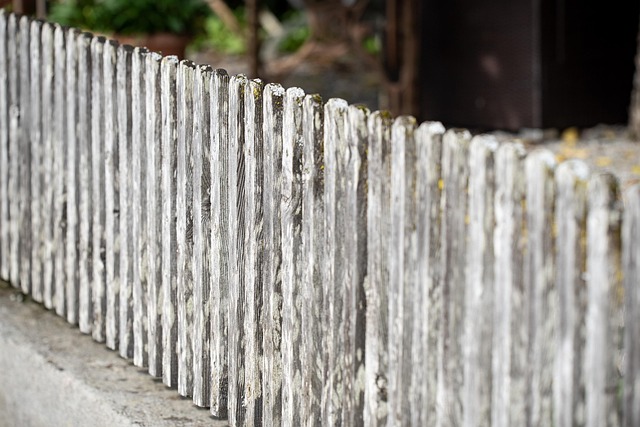Introduction:
Fences serve not only as structural elements but also as framing devices that enhance outdoor aesthetics. Regularly staining and sealing your wooden fence is essential for maintaining its beauty and longevity. This comprehensive guide delves into the intricacies of fence staining, from understanding its benefits and exploring various types to preparing your fence, choosing the perfect color, selecting the right sealants, and mastering maintenance techniques. By following these steps, you’ll ensure your wooden fence remains a striking focal point for years to come.
- Understanding Fence Staining: Benefits and Types
- Preparing Your Wooden Fence for Staining
- Choosing the Right Stain: Color Options and Applications
- Sealing for Protection: Best Practices and Products
- Maintenance Tips for Long-Lasting Fence Appearance
Understanding Fence Staining: Benefits and Types
Fence staining is an essential process that not only enhances the aesthetic appeal of your wooden fence but also provides numerous practical benefits. By applying a coat of stain, you create a protective barrier against the elements, including UV rays from the sun and harsh precipitation. This protection prevents the wood from fading, cracking, or warping over time. Regular staining can significantly extend the lifespan of your fence, saving you money on costly repairs or replacements.
There are various types of fence stains available in the market, each offering unique advantages. Water-based stains are environmentally friendly and easy to apply, often providing a transparent finish that lets the natural grain of the wood show. Semi-transparent options offer better coverage while still allowing some light to pass through, enhancing the wood’s appearance. Solid colors, on the other hand, provide complete opacity, ideal for those seeking a bold, new look. Each type has its pros and cons, catering to different preferences and specific needs.
Preparing Your Wooden Fence for Staining
Preparing your wooden fence for staining is a crucial step to ensure optimal results and extend the life of the finish. Begin by cleaning the fence thoroughly to remove any dirt, dust, or debris that may hinder adhesion. Use a pressure washer or a brush and mild detergent solution to achieve a clean surface. This initial cleaning will help the stain penetrate better and create a more even color.
After cleaning, inspect the wood for any signs of rot, cracks, or damaged areas. Repair or replace these sections before staining to maintain the fence’s structural integrity. Fill in any gaps with wood putty and sand the surface smooth once dry. A well-prepared fence will not only look better but also benefit from a longer-lasting stain, protecting it from the elements for years to come.
Choosing the Right Stain: Color Options and Applications
Choosing the right stain is an essential step in fencing maintenance. The first consideration is color, offering a wide array of options to suit any aesthetic preference. Traditional choices include natural wood tones that enhance the grain, but modern stains also provide vibrant colors and unique finishes like semi-transparent or solid coatings. These allow you to transform your wooden fence into a striking feature.
When deciding on an application method, you’ll typically select between brush, roller, or spray applicators. Brushes are best for intricate designs or corners, while rollers are efficient for large, flat areas. Sprays offer a quick, even coat but require proper ventilation and protective gear. Each method has its advantages, catering to different projects and preferences.
Sealing for Protection: Best Practices and Products
Sealing your wooden fence is an essential step to protect it from the elements, ensuring its longevity and preserving its beauty. The primary purpose of sealing is to create a barrier between the wood and moisture, UV rays, and other environmental factors that can cause fading, cracking, and rot. By selecting the right sealant, you can safeguard your fence against these issues, maintaining its appearance for years to come.
When choosing a sealant, opt for high-quality products designed specifically for outdoor use on wooden surfaces. Water-based sealants are a popular choice as they offer excellent protection while being environmentally friendly and easy to apply. These sealants form a protective coating that repels water, preventing moisture absorption into the wood. Ensure you follow the manufacturer’s instructions for application, allowing adequate drying time between coats for optimal results. Regular sealing, typically every 1-3 years depending on exposure, will keep your fence looking new and protect it from the constant wear and tear of outdoor conditions.
Maintenance Tips for Long-Lasting Fence Appearance
Regular maintenance is key to preserving the vibrant appearance of your stained and sealed wooden fence. Start by cleaning the fence at least once a year to remove any built-up dirt, mold, or mildew. Use a soft brush and a mild detergent, or a pressure washer for tougher stains. Avoid using harsh chemicals that could damage the finish. After cleaning, inspect the fence for any signs of wear, such as chipped paint or warped boards. Repair these issues promptly to prevent further damage.
For optimal protection, reapply the sealing coat every 2-3 years, or as recommended by the product manufacturer. This step is crucial, especially in areas with high moisture levels or frequent foot traffic. By following these simple maintenance tips, your wooden fence will not only retain its aesthetic appeal but also extend its lifespan, ensuring it remains a striking feature of your outdoor space for years to come.
